Pioneer XW-NAC3-R User Manual [en, es, fr]
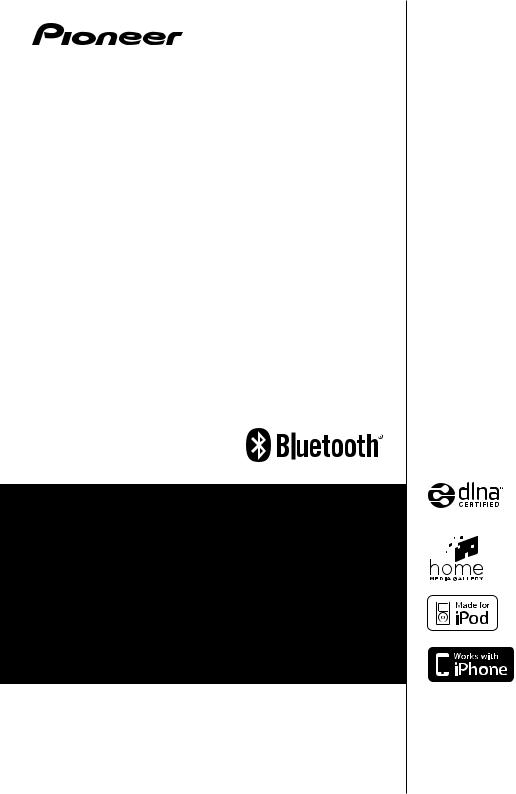
XW-NAC3-K/-W/-R
Digital Speaker System for iPod
Station d’accueil audio numérique pour iPod Sistema digital de parlantes para iPod
Discover the benefits of registering your product online at
http://www.pioneer.co.uk (or http://www.pioneer.eu).
Découvrez les nombreux avantages offerts en enregistrant votre produit en ligne maintenant sur
http://www.pioneer.fr (ou http://www.pioneer.eu).
Registre su producto en http://www.pioneer.es (o en http://www.pioneer.eu) Descubra los beneficios de registrarse on-line:
Operating Instructions
Mode d’emploi
Manual de instrucciones

IMPORTANT
CAUTION
RISK OF ELECTRIC SHOCK
DO NOT OPEN
The lightning flash with arrowhead symbol, within an equilateral triangle, is intended to alert the user to the presence of uninsulated “dangerous voltage” within the product’s enclosure that may be of sufficient magnitude to constitute a risk of electric shock to persons.
CAUTION:
TO PREVENT THE RISK OF ELECTRIC SHOCK, DO NOT REMOVE COVER (OR BACK). NO USER-SERVICEABLE PARTS INSIDE. REFER SERVICING TO QUALIFIED SERVICE PERSONNEL.
The exclamation point within an equilateral triangle is intended to alert the user to the presence of important operating and maintenance (servicing) instructions in the literature accompanying the appliance.
D3-4-2-1-1_A1_En
Information for users on collection and disposal of old equipment and used batteries
Symbol for |
These symbols on the products, packaging, and/or accompanying documents mean |
||||||
equipment |
that used electrical and electronic products and batteries should not be mixed with |
||||||
|
|
|
|
|
|
|
general household waste. |
|
|
|
|
|
|
|
|
|
|
|
|
|
|
|
For proper treatment, recovery and recycling of old products and used batteries, |
|
|
|
|
|
|
|
|
|
|
|
|
|
|
|
|
|
|
|
|
|
|
|
please take them to applicable collection points in accordance with your national |
|
|
|
|
|
|
|
legislation. |
|
|
|
|
|
|
|
By disposing of these products and batteries correctly, you will help to save valuable |
|
|
|
|
|
|
|
|
Symbol examples |
resources and prevent any potential negative effects on human health and the |
||||||
for batteries |
environment which could otherwise arise from inappropriate waste handling. |
||||||
|
|
|
|
|
|
|
For more information about collection and recycling of old products and batteries, |
|
|
|
|
|
|
|
|
|
|
|
|
|
|
|
please contact your local municipality, your waste disposal service or the point of sale |
|
|
|
|
|
|
|
where you purchased the items. |
|
|
|
|
|
|
|
These symbols are only valid in the European Union. |
|
|
|
|
|
|
|
For countries outside the European Union: |
|
|
|
|
|
|
|
|
|
|
|
|
|
|
|
If you wish to discard these items, please contact your local authorities or dealer and |
|
|
|
|
|
|
|
ask for the correct method of disposal. |
Pb
K058a_A1_En
WARNING
This equipment is not waterproof. To prevent a fire or shock hazard, do not place any container filled with liquid near this equipment (such as a vase or flower pot) or expose it to dripping, splashing, rain or moisture.
D3-4-2-1-3_A1_En
WARNING
Before plugging in for the first time, read the following section carefully.
The voltage of the available power supply differs according to country or region. Be sure that the power supply voltage of the area where this unit will be used meets the required voltage (e.g., 230 V or 120 V) written on the rear panel.
D3-4-2-1-4*_A1_En
WARNING
To prevent a fire hazard, do not place any naked flame sources (such as a lighted candle) on the equipment.
Operating Environment
Operating environment temperature and humidity: +5 °C to +35 °C (+41 °F to +95 °F); less than 85 %RH (cooling vents not blocked)
Do not install this unit in a poorly ventilated area, or in locations exposed to high humidity or direct sunlight (or strong artificial light)
D3-4-2-1-7c*_A1_En
WARNING
Store small parts out of the reach of children and infants. If accidentally swallowed, contact a doctor immediately.
D3-4-2-1-7a_A1_En

VENTILATION CAUTION
When installing this unit, make sure to leave space around the unit for ventilation to improve heat radiation (at least 10 cm at top, 10 cm at rear, and 10 cm at each side).
WARNING
Slots and openings in the cabinet are provided for ventilation to ensure reliable operation of the product, and to protect it from overheating. To prevent fire hazard, the openings should never be blocked or covered with items (such as newspapers, table-cloths, curtains) or by operating the equipment on thick carpet or a bed.
D3-4-2-1-7b*_A1_En
If the AC plug of this unit does not match the AC outlet you want to use, the plug must be removed and appropriate one fitted. Replacement and mounting of an AC plug on the power supply cord of this unit should be performed only by qualified service personnel. If connected to an AC outlet, the cut-off plug can cause severe electrical shock. Make sure it is properly disposed of after removal.
The equipment should be disconnected by removing the mains plug from the wall socket when left unused for a long period of time (for example, when on vacation).
D3-4-2-2-1a_A1_En
POWER-CORD CAUTION
Handle the power cord by the plug. Do not pull out the plug by tugging the cord and never touch the power cord when your hands are wet as this could cause a short circuit or electric shock. Do not place the unit, a piece of furniture, etc., on the power cord, or pinch the cord. Never make a knot in the cord or tie it with other cords. The power cords should be routed such that they are not likely to be stepped on. A damaged power cord can cause a fire or give you an electrical shock. Check the power cord once in a while. When you find it damaged, ask your nearest PIONEER authorized service center or your dealer for a replacement.
S002*_A1_En
CAUTION
The STANDBY/ON switch on this unit will not completely shut off all power from the AC outlet. Since the power cord serves as the main disconnect device for the unit, you will need to unplug it from the AC outlet to shut down all power. Therefore, make sure the unit has been installed so that the power cord can be easily unplugged from the AC outlet in case of an accident. To avoid fire hazard, the power cord should also be unplugged from the AC outlet when left unused for a long period of time (for example, when on vacation).
STANDBY/ON switch on this unit will not completely shut off all power from the AC outlet. Since the power cord serves as the main disconnect device for the unit, you will need to unplug it from the AC outlet to shut down all power. Therefore, make sure the unit has been installed so that the power cord can be easily unplugged from the AC outlet in case of an accident. To avoid fire hazard, the power cord should also be unplugged from the AC outlet when left unused for a long period of time (for example, when on vacation).
D3-4-2-2-2a*_A1_En
This product is for general household purposes. Any failure due to use for other than household purposes (such as long-term use for business purposes in a restaurant or use in a car or ship) and which requires period.
K041_A1_En
When using this product, confirm the safety information shown on the bottom of the unit.
D3-4-2-2-4_B1_En
[For UK model]
Replacement and mounting of an AC plug on the power supply cord of this unit should be performed only by qualified service personnel.
IMPORTANT: THE MOULDED PLUG
This appliance is supplied with a moulded three pin mains plug for your safety and convenience. A 5 amp fuse is fitted in this plug.
Should the fuse need to be replaced, please ensure that the replacement fuse has a rating of 5 amps and that it is approved by ASTA or BSI to BS1362.
Check for the ASTA mark  or the BSI mark
or the BSI mark  on the body of the fuse.
on the body of the fuse.
If the plug contains a removable fuse cover, you must ensure that it is refitted when the fuse is replaced. If you lose the fuse cover the plug must not be used until a replacement cover is obtained. A replacement fuse cover can be obtained from your local dealer.
If the fitted moulded plug is unsuitable for your socket outlet, then the fuse shall be removed and the plug cut off and disposed of safely. There is a danger of severe electrical shock if the cut off plug is inserted into any 13 amp socket.
If a new plug is to be fitted, please observe the wiring code as shown below. If in any doubt, please consult a qualified electrician.
IMPORTANT: The wires in this mains lead are coloured in accordance with the following code: Blue : Neutral Brown : Live
As the colours of the wires in the mains lead of this appliance may not correspond with the coloured markings identifying the terminals in your plug, proceed as follows; 
The wire which is coloured BLUE must be connected to the terminal which is marked with the letter N or coloured BLACK. The wire which is coloured BROWN must be connected to the terminal which is marked with the
letter L or coloured RED.
How to replace the fuse: Open the fuse compartment with a screwdriver and replace the fuse.
D3-4-2-1-2-2*_A2_En

Thank you for buying this Pioneer product.
Please read through these operating instructions so that you will know how to operate your model properly. After you have finished reading the instructions, put them in a safe place for future reference.
Contents
01 Before you start
Features . . . . . . . . . . . . . . . . . . . . . . . . . . . . . . 5 What’s in the box . . . . . . . . . . . . . . . . . . . . . . . 5
Before using the remote control . . . . . . . . . . . . 6
Replace the battery . . . . . . . . . . . . . . . . . . . . 6
Using the remote control . . . . . . . . . . . . . . . . 7
Installing the unit . . . . . . . . . . . . . . . . . . . . . . . 7 Plugging in . . . . . . . . . . . . . . . . . . . . . . . . . . . . 7
02 Controls and displays
Remote control . . . . . . . . . . . . . . . . . . . . . . . . . 8 Front/top panel . . . . . . . . . . . . . . . . . . . . . . . . 10
03 iPod/iPhone playback
Confirm what iPod/iPhone models are supported
. . . . . . . . . . . . . . . . . . . . . . . . . . . . . . . . . . . . 11
Connecting your iPod/iPhone . . . . . . . . . . . . . 11
Connecting your TV . . . . . . . . . . . . . . . . . . . 12
Playing your iPod/iPhone . . . . . . . . . . . . . . . . 12
SHUFFLE2 . . . . . . . . . . . . . . . . . . . . . . . . . . 14 HI-LITE Scan. . . . . . . . . . . . . . . . . . . . . . . . . 14
04 Bluetooth® AUDIO for Wireless
Enjoyment of Music
Wireless music play . . . . . . . . . . . . . . . . . . . . 16
Remote control operation. . . . . . . . . . . . . . . 16 About Bluetooth wireless technology . . . . . . 16
Setting the PIN code. . . . . . . . . . . . . . . . . . . . 17
Pairing this unit and Bluetooth wireless technology device . . . . . . . . . . . . . . . . . . . . . . 17
Listening to Music Contents of Bluetooth wireless technology device with Your System . . . . . . . . 18
Radio wave caution. . . . . . . . . . . . . . . . . . . . . 18 Scope of operation . . . . . . . . . . . . . . . . . . . . 19
Radio wave reflections . . . . . . . . . . . . . . . . . 19 Precautions regarding connections to products supported by this unit. . . . . . . . . . . . . . . . . . 19
About the playback screen . . . . . . . . . . . . . .25 About the Favorites folder . . . . . . . . . . . . . . . .25
Registering audio files and Internet radio stations in the Favorites folder . . . . . . . . . . .25 Deleting audio files and Internet radio stations from the Favorites folder . . . . . . . . . . . . . . . .25
Registering broadcast stations not on the vTuner list from the special Pioneer site . . . . . . . . . . .26 Advanced operations for Internet radio . . . . . .27 Saving Internet radio stations . . . . . . . . . . . .27 Retrieving saved Internet radio stations . . . .27
Setting up the network . . . . . . . . . . . . . . . . . .27
Checking the network settings . . . . . . . . . . .29
Ext. Vol Limit . . . . . . . . . . . . . . . . . . . . . . . . . .29
About network playback . . . . . . . . . . . . . . . . .30
Windows Media Player . . . . . . . . . . . . . . . . .30 Windows Media DRM . . . . . . . . . . . . . . . . . .30 DLNA . . . . . . . . . . . . . . . . . . . . . . . . . . . . . .30
Content playable over a network . . . . . . . . . .30 About playback behavior over a network . . . .31
Authorizing this unit . . . . . . . . . . . . . . . . . . .31 aacPlus. . . . . . . . . . . . . . . . . . . . . . . . . . . . .31 FLAC. . . . . . . . . . . . . . . . . . . . . . . . . . . . . . .31
06 Other connections
Connecting auxiliary components . . . . . . . . . .33
07 Sound settings
Using the Sound Retriever . . . . . . . . . . . . . . .34 Using the sound effects . . . . . . . . . . . . . . . . .34 Adjusting the bass and treble . . . . . . . . . . . . .35
08 Using the timer
Setting the clock . . . . . . . . . . . . . . . . . . . . . . .36
Changing the clock’s display mode . . . . . . .36 Setting the wake-up timer . . . . . . . . . . . . . . . .37 Turning the wake-up timer on/off . . . . . . . . .37
Using the sleep timer . . . . . . . . . . . . . . . . . . .37
05 Playback with HOME MEDIA
GALLERY inputs
Enjoying the Home Media Gallery . . . . . . . . . . 20 Steps to enjoy the Home Media Gallery. . . . . . 21 About playable file formats . . . . . . . . . . . . . . . 22 Connecting to the network through LAN interface
. . . . . . . . . . . . . . . . . . . . . . . . . . . . . . . . . . . . 23
Playback with Home Media Gallery. . . . . . . . . 23
4
09 Additional information
Troubleshooting . . . . . . . . . . . . . . . . . . . . . . .38 Resetting the system. . . . . . . . . . . . . . . . . . . .41 About Sound Retriever . . . . . . . . . . . . . . . . . .41 About iPod/iPhone . . . . . . . . . . . . . . . . . . . . .41 Specifications . . . . . . . . . . . . . . . . . . . . . . . . .42 Cleaning the unit. . . . . . . . . . . . . . . . . . . . . . .42
En

Before you start
Chapter 1:
Before you start
Features
1.Alternating mix playback using two iPod/iPhone units with SHUFFLE2
function
Alternating mix playback (SHUFFLE2) can be enjoyed by merely connecting two Apple iPod/iPhone units to this unit’s connector, and by pressing  on the unit or remote control. In addition to the automated SHUFFLE2 playback, you can also manually operate and switch between two iPod/ iPhone units, or play a digest of the music on the two iPod/iPhone units (HI-LITE SCAN).
on the unit or remote control. In addition to the automated SHUFFLE2 playback, you can also manually operate and switch between two iPod/ iPhone units, or play a digest of the music on the two iPod/iPhone units (HI-LITE SCAN).
2.Wireless Playback Using Bluetooth
wireless technology
Since this speaker system is equipped with Bluetooth wireless technology, you can listen to other Bluetooth-enabled devices (cell phones, digital music players, etc.) without the need for a cable connection. Even when using a wireless connection, high quality sound is assured by means of the Sound Retriever Air function, which helps prevent signal deterioration.
4.High Fidelity Sound Design
In addition to its 2-channel full-range speaker, this unit also features a low-range passive radiator speaker, producing powerful, high-quality sound.
In addition, the Sound Retriever function augments sound quality lost in compression, allowing rich sound like that produced by conventional CDs.
5.Enjoy iPod/iPhone Images
Since this unit is equipped with a video output connector, the unit can be connected to a TV in order to view photographs and music videos stored in your iPod/iPhone.
What’s in the box
Please confirm that the following accessories are in the box when you open it.
•Remote control
•Lithium battery (CR2025)
(The lithium battery has been factory installed in the remote control unit.)
•Power cord
•USB terminal cover (included with product)
3.Network Multimedia Function
This unit can be used to listen to the newest kinds of digital content, including music libraries stored within a networkconnected computer, Internet radio, or music files stored on USB memory devices.
•Warranty card
•Operating instructions (This document)
01
Español Français English
5
En

01 Before you start
Before using the remote control
The battery supplied with this unit is stored in the battery casing.
•Remove the protective seal from the
battery casing.
When you notice a decrease in the operating range, replace the battery (see below).
Replace the battery
When replacing the battery, use a commercially available Lithium CR2025 battery.
1
 1
1  3
3 
2
1While pushing the release tab, pull out the battery casing.
2Remove the battery from the casing.
3Place a new battery in the casing.
Make sure the side of the battery is facing up when you place it in the space provided.
6
 Caution
Caution
When using lithium batteries, please observe the following:
•There is danger of explosion if the battery is incorrectly replaced. Make sure to replace only with the same or equivalent type recommended by the manufacturer.
•Dispose of used battery cells immediately after replacement. Keep away from children.
•If swallowed, please contact a doctor immediately.
•Lithium batteries may present a fire or chemical burn hazard if misused. Do not disassemble, heat above 100 °C, or incinerate.
•Remove the battery if the unit isn’t going to be used for a month or more.
•When disposing of used batteries, please comply with governmental regulations or environmental public instruction’s rules that apply in your country or area.
•WARNING
Do not use or store batteries in direct sunlight or other excessively hot place, such as inside a car or near a heater. This can cause batteries to leak, overheat, explode or catch fire. It can also reduce the life or performance of batteries.
En
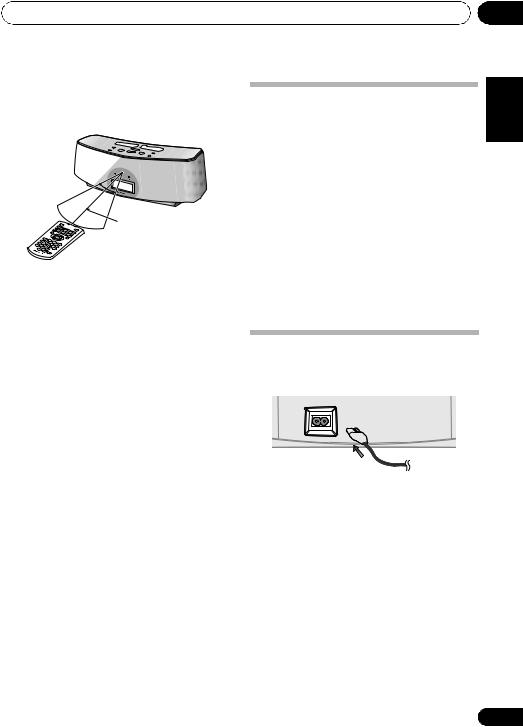
Before you start |
01 |
Using the remote control
The remote has a range of about 7 m at an angle of about 30º from the remote sensor.
30° 30°
7 m
Keep in mind the following when using the remote control:
•Make sure that there are no obstacles between the remote and the remote sensor on the unit.
•Remote operation may become unreliable if strong sunlight or fluorescent light is shining on the unit’s remote sensor.
•Remote controllers for different devices can interfere with each other. Avoid using remotes for other equipment located close to this unit.
•Replace the batteries when you notice a fall off in the operating range of the remote.
Installing the unit
•When installing this unit, make sure to put it on a level and stable surface.
Don’t install it on the following places:
–on a color TV (the screen may distort)
–near a cassette deck (or close to a device that gives off a magnetic field). This may interfere with the sound.
–in direct sunlight
–in damp or wet areas
–in extremely hot or cold areas
–in places where there is vibration or other movement
–in places that are very dusty
–in places that have hot fumes or oils (such as a kitchen)
Plugging in
After you’ve finished making all connections, plug the unit into an AC outlet.
AC IN
1Plug the supplied power cord into the AC IN socket on the back of the unit.
2Plug the other end into a power outlet.
 Important
Important
•Before making or changing any connections, switch off the power and disconnect the power cord from the AC outlet.
Español Français English
7
En
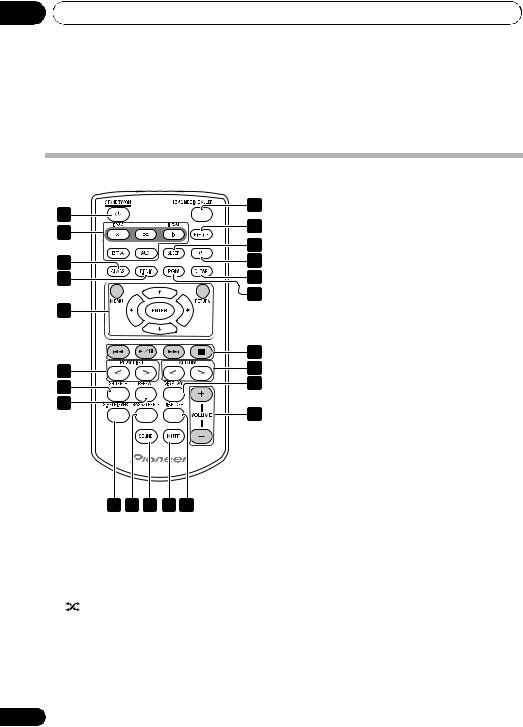
02 Controls and displays
Chapter 2:
Controls and displays
Remote control
|
|
iPod b |
|
1 |
9 |
Switches the input to the iPod/iPhone |
|
10 |
connected to the iPod b connector port. |
||
2 |
BT A |
||
11 |
|||
|
Switches the input to Bluetooth AUDIO. |
||
3 |
12 |
AUX |
|
4 |
13 |
Switches the input to external input. |
|
|
14 |
3 CLASS |
|
5 |
|
||
|
Switches between the three banks (classes) of |
||
|
|
radio station presets (page 27). |
|
15 |
|
6 |
16 |
|
17 |
||
7 |
||
|
||
8 |
18 |
|
|
19 20 21 22 23
1 STANDBY/ON
Switches the unit between standby and on.
2iPod a
Switches the input to the iPod/iPhone connected to the iPod a connector port.
When iPod/iPhone are connected to both connector ports iPod a and iPod b, the SHUFFLE2 function can be used to alternately play tracks on iPod a and iPod b (page 14).
4 T.EDIT (TUNER EDIT)
Use to save Internet radio stations (page 27).
5MENU
Press to make various settings.
/ / /
Use these to select items, change settings.
ENTER
Use this to implement the selected item or enter a setting that you have changed.
RETURN
Use to return to the previous menu or the category list screen.
6PLAYLIST < / >
Use these to select playlists to be played on iPod/iPhone.
7 SHUFFLE
Perform shuffle play of tracks on the selected iPod/iPhone or USB memory device (page 13).
8 REPEAT
Perform repeat play of tracks on the selected iPod/iPhone or USB memory device (page 13).
8
En
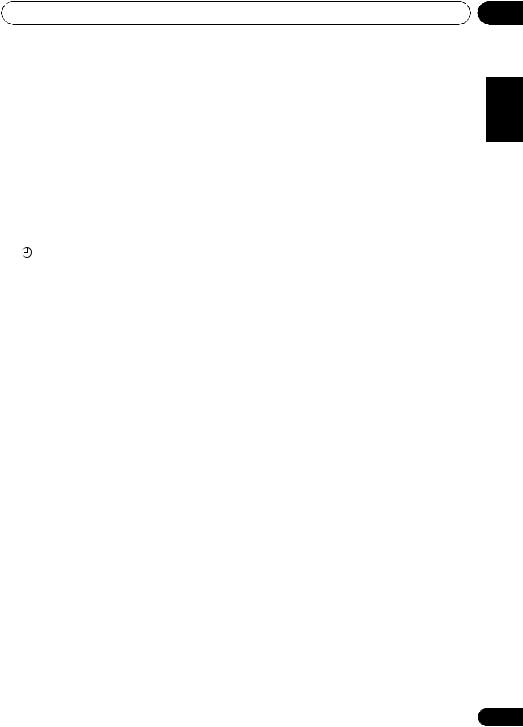
Controls and displays |
02 |
9 HOME MEDIA GALLERY
Switches the input to internet radio, a USB storage device or server components on the network (page 21).
10 HI-LITE
If an iPod/iPhone is connected to the connector port, the HI-LITE function can be used to playback part of the track (page 14).
11 SLEEP
Use to put the unit in sleep mode and select the amount of time before sleep (page 37).
12
Use to turn the wake-up timer function ON/OFF (page 37). Also use to switch the clock display functions (page 36).
13 CLEAR
Use to delete audio files and Internet radio stations from the Favorites folder (page 25).
14 PGM
Use to register audio files and Internet radio stations in the Favorites folder (page 25).
15 Playback control buttons
Use when operating an iPod/iPhone, Bluetooth wireless technology device, USB storage device, internet radio and the music files stored in PC’s with this remote control
(page 12, 18, 23).
16 ALBUM < / >
Use these to select albums to play on iPod/ iPhone.
17 DISPLAY
Switches the track information (artist name/ album name) each time the button is pressed during playback.
18 VOLUME +/–
Use to set the listening volume.
19 S.RETRIEVER
Use to turn the Sound Retriever function ON/ OFF (page 34).
20 BASS/TREBLE
Use the bass and treble controls to adjust the overall tone (page 35).
21 SOUND
Switches Sound modes (page 34).
22 MUTE
Press to temporarily silence the sound.
23 DISP OFF
Turns the display off except when pressing the buttons.
Español Français English
9
En
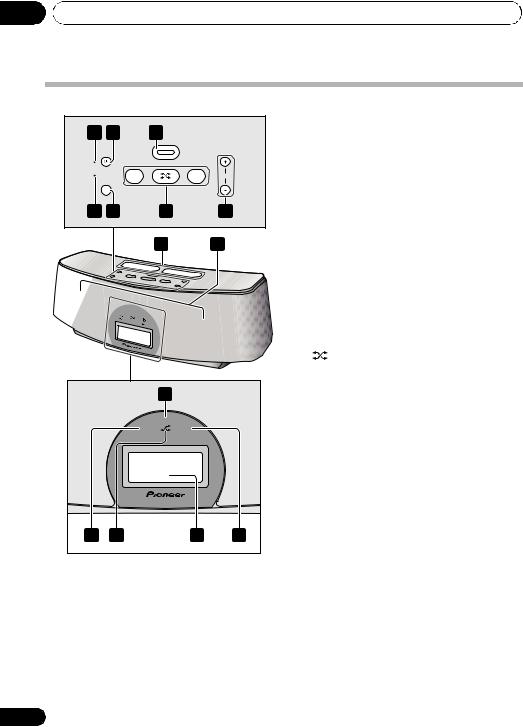
02 Controls and displays
Front/top panel
1 |
2 |
5 |
|
|
|
|
USB |
|
|
STANDBY/ON |
|
|
|
|
TIMER |
|
a |
b |
|
WAKE UP(GREEN) |
|
VOLUME |
||
SLEEP(ORANGE) |
|
|
||
INPUT |
|
|
|
|
SELECTOR |
|
|
|
|
3 |
4 |
6 |
|
7 |
8 9
14
a  b
b
iPod |
iPod |
10 |
11 |
12 |
13 |
1 Power Indicator
Lights when the power is on.
2 STANDBY/ON
Switches the unit between standby and on.
3 TIMER indicator
When the wake-up timer is set to ON, this indicator lights green. When the sleep timer is set to ON, this indicator lights orange.
10
4 INPUT SELECTOR
Use to select an input source. Press repeatedly to switch between iPod a, iPod b, Bluetooth AUDIO (BT AUDIO), Home Media Gallery and external input (AUX).
5 USB terminal
When no USB storage device is connected, install the USB terminal cover.
WARNING
Store the USB terminal cover out of the reach of children and infants. If accidentally swallowed, contact a doctor immediately.
6 a
Switches the input to the iPod/iPhone connected to the iPod a connector port.
When iPod/iPhone are connected to both connector ports iPod a and iPod b, the
SHUFFLE2 function can be used to alternately play tracks on iPod a and iPod b (page 14).
b
Switches the input to the iPod/iPhone connected to the iPod b connector port.
7 VOLUME +/–
Use to set the listening volume.
8iPod/iPhone connector ports
9Speaker units
10iPod a indicator
Lights when the iPod a input is selected.
11 SHUFFLE2 indicator
Lights when the SHUFFLE2 function is on.
12Display
13iPod b indicator
Lights when the iPod b input is selected.
14 Remote control sensor
En
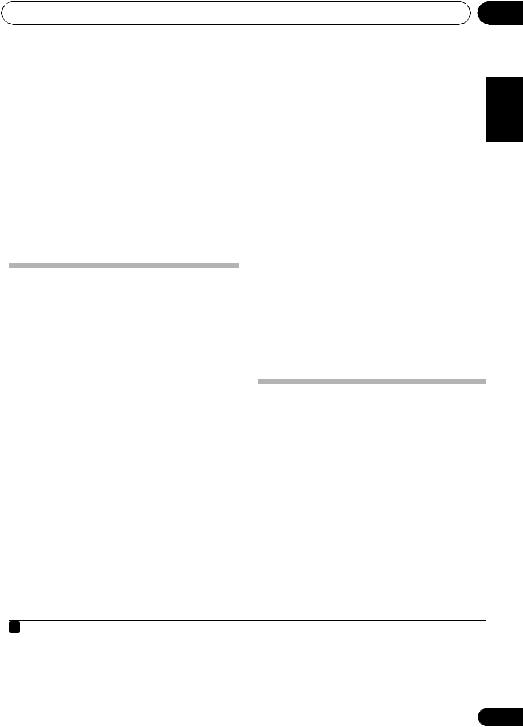
iPod/iPhone playback
Chapter 3:
iPod/iPhone playback
Merely by connecting your iPod/iPhone to this speaker system, you can enjoy high-quality sound from your iPod/iPhone. This unit can also be connected to a television set, letting you view images from your iPod/iPhone.
Playback and volume level setting for iPod/ iPhone music and images can be performed from this unit or the iPod/iPhone itself.
Confirm what iPod/iPhone models are supported
The iPod/iPhone playable on this unit are shown below.1
iPod/iPhone |
Audio |
Control |
Video |
iPod nano 1/2G |
|
|
|
iPod nano 3/4/5G |
|
|
|
iPod 5G |
|
|
|
iPod classic 2007 |
|
|
|
iPod classic 2008 |
|
|
|
iPod classic 2009 |
|
|
|
iPod touch 1G |
|
|
|
iPod touch 2G |
|
|
|
iPod touch 2G 2009 |
|
|
|
iPhone |
|
|
|
iPhone 3G/3GS |
|
|
|
Always use the most recent version of iPod/ iPhone software available. Operation compatibility may vary depending on the version of the software used. You can confirm your software version by operating your iPod/ iPhone as follows:
1Select ’Settings’ from the top menu.
When using iPod touch or iPhone, select ‘General’ after selecting ‘Settings’.
2Select ’About’.
The software version will be displayed.
•Consult the Apple website regarding the newest software versions and instructions on how to update your version.
 Tip
Tip
•When using an iPod/iPhone not supported by this unit, use a commercially available cable to connect the iPod/iPhone to the AUX IN connector of this unit.
Connecting your iPod/iPhone
 Caution
Caution
•When connecting one or two iPod/iPhone units, always use the dock adapter provided with your iPod/iPhone, or a commercially adapter designed to support iPod/iPhone. The iPod/iPhone cannot be connected without a dock adapter; attempting to connect an iPod/iPhone without a dock adapter will cause damage or malfunction.
03
Español Français English
 Note
Note
1• Pioneer does not guarantee that this unit plays iPod/iPhone other than the ones specified.
•Some functions may be restricted depending on the model or software version.
•iPod/iPhone is licensed for reproduction of non-copyrighted materials or materials the user is legally permitted to reproduce.
•Features such as the equalizer cannot be controlled using this system, and we recommend switching the equalizer off before connecting.
•Pioneer cannot under any circumstances accept responsibility for any direct or indirect loss arising from any inconvenience or loss of recorded material resulting from the iPod/iPhone failure.
•For detailed instructions on using the iPod/iPhone, please refer to the manual supplied with the iPod/iPhone.
11
En

03 iPod/iPhone playback
iPod nano/ iPod classic/ iPod touch/ iPhone
|
MENU |
|
|
Dock adapter |
|
|
 Caution
Caution
•Before making or changing the connections, switch off the power and disconnect the power cord from the power outlet. Plugging in should be the final step.
MENU
TV
1 Attach the Dock adapter to iPod/iPhone connector port on the top panel of this unit.
•An iPod/iPhone Dock adapter is not supplied with this unit.
When attaching the Dock adapter, be sure to orient the front-back directions of the Dock adapter correctly. To attach, first place the protruding tabs on the front side of the adapter into the depressions on the iPod/iPhone connector port and press into position. When attaching the adapter, be careful not to strike the connectors.
2 Connect your iPod/iPhone.
Connecting your TV
To watch iPod/iPhone images on a television, perform connections using a composite video cable.
•When an iPod/iPhone is connected to this
unit, the iPod/iPhone’s TV output setting is automatically set to ON.1
Composite video cable (commercially available)
VIDEO
OUT
AUX
IN
Playing your iPod/iPhone
 Caution
Caution
•When your iPod is connected to this unit and you wish to operate the iPod/iPhone by touching it directly, be sure to hold the iPod/iPhone steady with the other hand to prevent malfunctions due to faulty contacts.
When the iPod/iPhone function is selected, if an iPod/iPhone is connected to the connector port iPod a or b, ‘iPod a/b Connecting’ will be displayed while the device is being confirmed.2
Playback and volume level setting for iPod/ iPhone music and images can be performed from this unit or the iPod/iPhone itself.
Note
1• Some iPods allow the TV output setting to be changed while connected.
• When the iPod/iPhone is disconnected from this unit, the iPod/iPhone’s TV output setting returns to its original state.
2If an iPod/iPhone is connected when the iPod/iPhone is in playback mode and this unit is in standby mode, the power will turn on and playback of the iPod/iPhone will begin.
12
En
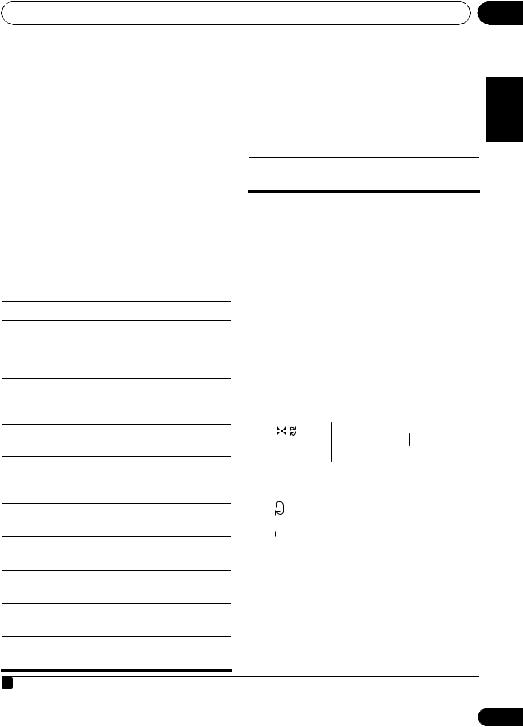
iPod/iPhone playback |
03 |
•When using the iPod/iPhone to adjust sound volume, the adjustment will be
applied only to the sound produced from this unit’s speakers.1 If the iPod/iPhone is disconnected from this unit, the iPod’s sound volume will return to its original setting.
When playing a single iPod/iPhone, press iPod a or iPod b to switch to the respective mode.
The following operations are possible for iPod/ iPhone, using the remote control.
Button |
What it does |
|
|
/ Starts normal playback and pauses/ unpauses playback.
Pauses playback.
Press to skip to the start of the current file, then previous files. Press and hold to start fast reverse scanning.
Press to skip to the next file. Press and hold to start fast forward scanning.
VOLUME Use to set the listening volume.
+/–
SHUFFLE The currently selected iPod/iPhone tracks are played back in random order (shuffle play).
REPEAT The currently selected iPod/iPhone tracks are played back repeatedly.a
MENU Use to access the iPod/iPhone menu.
Button |
What it does |
|
|
DISPLAY Switches the track information (artist name/album name) each time the button is pressed during playback.
DISP OFF Turns the display off except when pressing the buttons.
aPress repeatedly to switch between repeat play options. ‘Repeat’ plays the currently playing file repeatedly. ‘Repeat ALL’ plays all the files repeatedly.
When no device is connected to the selected iPod/iPhone connector ports (iPod a or iPod b) and this unit is not operated for 30 minutes or more after the respective function is selected, power will automatically turn OFF.
While playing an iPod/iPhone unit, the track information is displayed on this unit’s display.
Function |
Song name |
||||||
|
|
|
|
|
|
||
|
|
|
|
|
|
|
|
|
|
|
|
|
|
|
|
|
i |
|
P |
o |
d |
a |
|
|
|
|
|||||
|
S |
o |
n |
g |
n |
a m e |
|
|
A |
r |
t |
i |
s t |
n a m e |
|
|
|
|
|
|
|
0 : 0 0 |
|
Time
Artist name/Album name
Play mode
: Repeat 1
 : Repeat all
: Repeat all 
 : Shuffle
: Shuffle
/ / Use to control the iPod/iPhone
ENTER menu.
PLAYLIST Use these to select playlists to be < / > played on iPod/iPhone.
ALBUM Use these to select albums to be < / > played on iPod/iPhone.
When playing two iPod/iPhone units
alternately, press  to perform SHUFFLE2 play.
to perform SHUFFLE2 play.
 Note
Note
1 These adjustments are applied to all inputs to the unit.
Español Français English
13
En

03 iPod/iPhone playback
SHUFFLE2
Two iPod/iPhone units can be played alternately with no break in sound (SHUFFLE2). A bit before the currently playing iPod/iPhone track ends, playback begins on the other iPod/ iPhone track and the volume is gradually raised to fade in seamlessly (Cross fade).
During the SHUFFLE2 operation, the order of track playback is set by the shuffle function.
1Connect two iPod/iPhone units to the iPod/iPhone connector ports (iPod a, iPod b), then press iPod a or iPod b.
2Press MENU to access the iPod/iPhone menu.
3Select the track area that you want to play back, then press ENTER.
4Press  .
.
The SHUFFLE2 mode is set, and the SHUFFLE2 indicator lights; the unit connected to the iPod a connector port will playback.
A bit before the currently playing iPod/iPhone track ends, the other iPod/iPhone unit begins cross fade playback. The same operation is repeated thereafter until all tracks on both units have been played.1
•To cancel the SHUFFLE2 mode, press either  once again, or .
once again, or .
•The SHUFFLE2 mode will also be canceled if the function is switched to any another input (including iPod a or iPod b).
HI-LITE Scan
Each track is played back for a few seconds at a certain time from the track beginning, thus allowing desired tracks to be found quickly.
1Connect an iPod/iPhone to the iPod/ iPhone connector ports, then press iPod a or iPod b.
2Press MENU to access the iPod/iPhone menu.
3Select the track area that you want to play back, then press ENTER.
4Press HI-LITE.
HI-LITE scan function will begin from the first track on the selected iPod/iPhone.
If playback was already underway, the HI-LITE scan will begin from the currently playing track.
After a track is played for a few seconds, the next track will be found and a certain time2 from the track beginning will be played for a few seconds.
When two iPod/iPhone units are connected simultaneously, the first track on the alternate iPod/iPhone will be found and a certain time from the track beginning will be played for a few seconds.
Thereafter, the same process will be repeated until all tracks have been found and played for a few seconds each.
•To cancel the HI-LITE Scan operation, press HI-LITE once more.
•The HI-LITE Scan mode will also be canceled if the function is switched to any another input (including iPod a or iPod b).
 Note
Note
1During Cross Fade operation, /, and / are deactivated.
2If a track’s total length is too short, the track will be played back from the track beginning for a few seconds.
14
En

iPod/iPhone playback
 Important
Important
If the power indicator and iPod/iPhone indicator flash simultaneously, a connection fault is indicated. Perform the following troubleshooting checks:
•Check whether the iPod/iPhone was supported by this unit.
•Reconnect the iPod/iPhone to the unit. If this doesn’t seem to work, try resetting your iPod/iPhone.
•Update the iPod/iPhone software to the latest version.
If the iPod/iPhone cannot be operated, check the following items:
•Is the iPod/iPhone connected correctly? Reconnect the iPod/iPhone to the unit.
•Is the iPod/iPhone experiencing a hangup? Try resetting the iPod/iPhone, and reconnect it to the unit.
 Tip
Tip
•iPod/iPhone recharging occurs whenever an iPod/iPhone is connected to this unit. (This function is supported in standby mode as well.)
•If an iPod/iPhone unit is connected to this unit when it is already in play mode, turning the unit’s power ON or switching input to iPod will cause iPod/iPhone playback to automatically begin.
•When this unit’s power is turned ON with another function is selected, even if an iPod/iPhone in play mode is connected, playback will not automatically begin.
•When input is switched from iPod to another function, the iPod/iPhone’s power will be turned OFF automatically.
•If the unit is set to standby when an iPod/ iPhone is connected, the iPod/iPhone’s power will be turned OFF automatically.
03
Español Français English
15
En
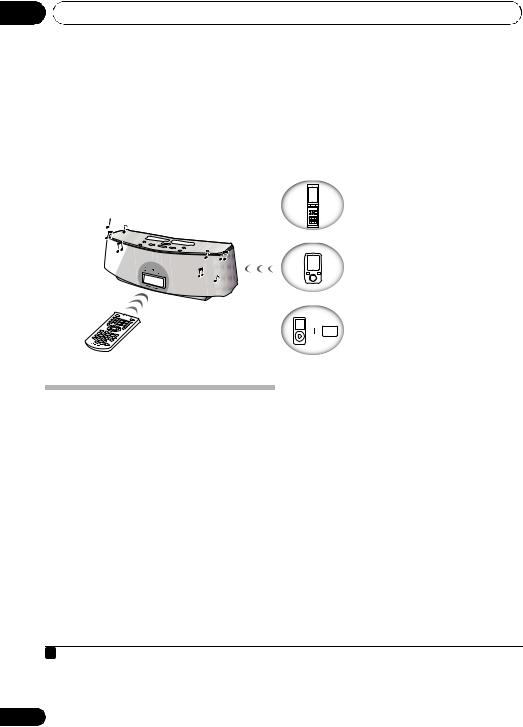
04 Bluetooth ® AUDIO for Wireless Enjoyment of Music
Chapter 4:
Bluetooth® AUDIO for Wireless Enjoyment of Music
Bluetooth wireless
technology enabled device:
Cell phone
This unit
Bluetooth wireless technology enabled device:
Digital music player
Device not equipped with Bluetooth wireless technology:
Digital music player
+
Bluetooth audio transmitter
(sold commercially)
Remote control operation
Wireless music play
This unit is furnished with a built-in Bluetooth® ADAPTER (Pioneer Model No. AS-BT100); as a result, any product equipped with Bluetooth wireless technology (portable cell phone, digital music player, etc.) can be used to listen to music wirelessly.1 Also, by using a commercially available transmitter supporting Bluetooth wireless technology, you can listen to music on a device not equipped with Bluetooth wireless technology. This unit supports SCMS-T contents protection, so music can also be enjoyed on devices equipped with SCMS-T type Bluetooth wireless technology.
Remote control operation
The remote control supplied with this unit allows you to play and stop media, and perform other operations.2
About Bluetooth wireless
technology
The Bluetooth word mark and logos are owned by the Bluetooth SIG, Inc. and any use of such marks by Pioneer Corporation is under license. Other trademarks and trade names are those of their respective owners.
 Note
Note
1• It must be necessary that the Bluetooth wireless technology enabled device supports A2DP profiles.
•Pioneer does not guarantee proper connection and operation of this unit with all Bluetooth wireless technology enabled devices.
2• It must be necessary that the Bluetooth wireless technology enabled device supports AVRCP profiles.
•Remote control operations cannot be guaranteed for all Bluetooth wireless technology enabled devices.
16
En

Bluetooth ® AUDIO for Wireless Enjoyment of Music |
04 |
Setting the PIN code
Set this unit’s PIN code to the same setting as that for the Bluetooth wireless technology device used. Supported PIN code setting values include 0000, 1234 or 8888.
• Default setting: 0000
|
|
USB |
|
STANDBY/ON |
|
|
|
TIMER |
a |
b |
|
WAKE UP(GREEN) |
VOLUME |
||
SLEEP(ORANGE) |
|
||
INPUT |
|
|
|
SELECTOR |
|
|
|
1 Press BT A.
When the Bluetooth wireless technology device is not connected, ‘Device Disconnected’ is displayed. If the Bluetooth wireless technology device is connected, disconnect it.
2 When ’Device Disconnected’ is displayed, press and hold VOLUME – on the top panel, and then press and hold STANDBY/ON for
three seconds.
The PIN code will be changed, and the newly set PIN code will be displayed. Choose between ‘0000’, ‘1234’ and ‘8888’.
Repeat step 2 until the PIN code is reset to the value desired.
These settings are preserved in memory even when the power is turned OFF. When resetting the PIN code, turn the power ON, and perform step 2 without any unit connected.
Pairing this unit and Bluetooth wireless technology device
“Pairing” must be done before you start playback of Bluetooth wireless technology content using Bluetooth AUDIO. Make sure to perform pairing first time you operate the system or any time pairing data is cleared. “Pairing” is the step necessary to register Bluetooth wireless technology device to enable Bluetooth communications.1 For more details, see also the operating instructions of your Bluetooth wireless technology device.
1 Press BT A.
When the Bluetooth wireless technology device is not connected, ‘Device Disconnected’ is displayed. If the Bluetooth wireless technology device is connected, disconnect it.
2 When ’Device Disconnected’ is displayed,
press .
‘Pairing’ will be displayed, and the unit will enter the pairing standby mode.
3 Switch on the Bluetooth wireless technology device that you want to perform pairing with, place the device within 1 meter
of the system, and set it to the pairing mode.
Pairing begins.
4 Check to see that the Bluetooth AUDIO is detected by the Bluetooth wireless
technology device.
‘Device Connected’ is displayed when Bluetooth wireless technology device is connected. Then the connected device name is displayed.
Español Français English
 Note
Note
1• Pairing is required when you first use Bluetooth wireless technology device and this unit.
• To enable Bluetooth communication, pairing should be done with both of your system and Bluetooth wireless technology device.
17
En

04 Bluetooth ® AUDIO for Wireless Enjoyment of Music
‘Device Disconnected’ is displayed when Bluetooth wireless technology device is not connected. In this case, perform the connection operation from the side of the Bluetooth wireless technology device.
Listening to Music Contents of Bluetooth wireless technology device with Your System
1 Press BT A to switch to Bluetooth AUDIO
input mode.
‘Device Disconnected’ is displayed.
2Connect the Bluetooth wireless technology device to the Bluetooth AUDIO.
3Start playback of music contents stored in
Bluetooth wireless technology device.
The following operations are now possible for Bluetooth wireless technology devices, using the remote control.1
Radio wave caution
This unit uses a 2.4 GHz radio wave frequency, which is a band used by other wireless systems (see list below). To prevent noise or interrupted communication, do not use this unit nearby such devices, or make sure these devices are switched off during use.
•Cordless phones
•Cordless facsimiles
•Microwave ovens
•Wireless LAN devices (IEEE802.11b/g)
•Wireless AV equipment
•Wireless controllers for game systems
•Microwave-based health aids
•Some baby monitors
Other, less common, equipment that may operate on the same frequency:
•Anti-theft systems
•Amateur radio stations (HAM)
Button |
What it does |
|
|
/ Starts normal playback and pauses/ unpauses playback.
Stops playback.
Press to skip to the start of the current file, then previous files. Press and hold to start fast reverse scanning.
Press to skip to the next file. Press and hold to start fast forward scanning.
VOLUME Use to set the listening volume.
+/–
When no Bluetooth wireless technology device is connected and this unit is not operated for 30 minutes or more after the Bluetooth AUDIO function is selected, power will automatically turn OFF.
•Warehouse logistic management systems
•Discrimination systems for train or emergency vehicles
 Note
Note
•In the event noise appears in your television image, there is the possibility that a Bluetooth wireless technology enabled device or this unit (including products supported by this unit) are causing signal interference with the antenna input connector of your television, video, BS tuner, CS tuner, etc.
In this event, increase the distance between the antenna input connector and the Bluetooth wireless technology enabled device or this unit (including products supported by this unit).
 Note
Note
1• Bluetooth wireless technology device should be compatible with AVRCP profile.
• Depending on Bluetooth wireless technology device you use, operation may differ from what is shown in this table.
18
En

Bluetooth ® AUDIO for Wireless Enjoyment of Music |
04 |
•If there is something obstructing the path between this unit (including devices supported by this unit) and the device equipped with Bluetooth wireless technology (such as a metal door, concrete wall, or insulation containing tinfoil), you may need to change the location of your system to prevent signal noise and interruptions.
Scope of operation
Use of this unit is limited to home use. (Transmission distances may be reduced depending on communication environment).
In the following locations, poor condition or inability to receive radio waves may cause the audio to be interrupted or stopped:
•In reinforced concrete buildings or steel framed or iron-framed buildings.
•Near large metallic furniture.
•In a crowd of people or near a building or obstacle.
•In a location exposed to the magnetic field, static electricity or radio wave interference from radio communication equipment using the same frequency band (2.4 GHz) as this unit, such as a 2.4 GHz wireless LAN device (IEEE802.11b/g) or microwave oven.
•If you live in a heavily populated residential area (apartment, townhouse, etc.) and if your neighbor’s microwave is placed near your system, you may experience radio wave interference. If this occurs, move your unit to a different place. When the microwave is not in use, there will be no radio wave interference.
Radio wave reflections |
English |
||
The radio waves received by this unit include |
|||
the radio wave coming directly from the device |
|||
equipped with Bluetooth wireless technology |
|||
(direct wave) and waves coming from various |
|
||
directions due to reflections by walls, furniture |
|
|
|
and building (reflected waves). The reflected |
|
Français |
|
well as variation in reception condition |
|
||
waves (due to obstacles and reflecting objects) |
|
|
|
further produce a variety of reflected waves as |
|
|
|
depending on locations. If the audio cannot be |
|
|
|
|
|
||
received properly due to this phenomenon, try |
|
||
moving the location of the device equipped |
Español |
||
with Bluetooth wireless technology a little. Also |
|||
|
|||
note that audio may be interrupted due to the reflected waves when a person crosses or approaches the space between this unit and the device equipped with Bluetooth wireless technology.
Precautions regarding connections to products supported by this unit
•Complete connections for all devices supported by this unit, including all audio cords and power cables before connecting them to this unit.
•After completing connections to this unit, check the audio and power cables to confirm that they not twisted together.
•When disconnecting this unit, confirm that you have sufficient working space in the surrounding area.
•When changing connections of audio or other cables for products supported by this unit, confirm that you have sufficient working space in the surrounding area.
19
En

05 Playback with HOME MEDIA GALLERY inputs
Chapter 5:
Playback with HOME MEDIA GALLERY inputs
Enjoying the Home Media Gallery
This unit’s Home Media Gallery function allows you to listen to audio files or listen to Internet radio stations on a computer or other component connected to this unit’s LAN terminal. This chapter describes the connection, setup, and playback procedures required to enjoy these features. It is advisory that you also refer to the operation manual supplied with your network component.
 Important
Important
•The Home Media Gallery allows you to play music on media servers connected on an identical Local Area Network (LAN) as the receiver. This unit allows for the playing of files stored on the following:
-PCs running Microsoft Windows Vista or XP with Windows Media Player 11 installed
-PCs running Microsoft Windows 7 with Windows Media Player 12 installed
-DLNA-compatible digital media servers (on PCs or other components)
-Files stored in a PC or DMS (Digital Media Server) as described above can be played via command from an external Digital Media Controller (DMC). The device used to play files under the control of the DMC is called a Digital Media Renderer (DMR*). The XW-NAC3 unit supports the use of such DMR components. When selecting a DMC or DMS, use only those that have received DLNA certification.
*: DMR is a device class certified by DLNA.
-During use of a DMR, an external controller can be used to start and stop playback of files. Control of sound volume and the MUTE function are also possible.1
-When a DMR is in use, if the XW-NAC3’s remote control is operated, DMR operation will be canceled (this excludes the use of certain buttons including VOLUME, MUTE, and DISPLAY).
•To play back audio files stored on components on the network or listen to Internet radio stations, you must turn on the DHCP server function of your router. In case your router does not have the builtin DHCP server function, it is necessary to set up the network manually. Otherwise, you cannot play back audio files stored on components on the network or listen to Internet radio stations. See page 27.
 Note
Note
1Depending on the external controller used, playback may be interrupted when the controller is used to adjust the sound volume. In this event, perform sound volume adjustments from the main unit or the remote control unit.
20
En

Playback with HOME MEDIA GALLERY inputs
Steps to enjoy the Home Media
Gallery
1 Connect to the network through LAN
interface.
See page 23.
2 Configure the network settings.
The setup is necessary only when the router to be connected does not have the built-in DHCP server function. See page 27.
3 Playback with Home Media Gallery.
See page 23.
•Playback the music files stored in USB
storage devices or PCs1
You can playback a lot of music stored in USB storage devices or your PCs using this unit. See page 22.
• Listening to Internet radio stations
You can select and listen to your favorite Internet radio station from the list of Internet radio stations created, edited, and managed by the vTuner database service exclusively for use with the Pioneer products. See page 26.
05
Español Français English
 Note
Note
1Besides a PC, you can also play back audio files stored on your other components with the built-in media server function based on DLNA 1.0 and 1.5 framework and protocols (i.e. network-capable hard disks and audio systems).
21
En

05 Playback with HOME MEDIA GALLERY inputs
About playable file formats
Category |
Extension |
Stream |
|
|
MP3a |
.mp3 |
MPEG-1 Audio Layer-3 |
Sampling frequency |
8 kHz to 48 kHz |
|
|
|
Quantization bitrate |
16 bit |
|
|
|
|
|
|
|
|
Channel |
2 ch |
|
|
|
|
|
|
|
|
Bitrate |
8 kbps to 320 kbps |
|
|
|
|
|
|
|
|
VBR/CBR |
Not supported/Supported |
|
|
|
|
|
LPCM |
_b |
LPCM |
Sampling frequency |
8 kHz to 48 kHz |
|
|
|
Quantization bitrate |
16 bit, 20 bit, 24 bit |
|
|
|
|
|
|
|
|
Channel |
2 ch |
|
|
|
|
|
WAV |
.wav |
LPCM |
Sampling frequency |
8 kHz to 48 kHz |
|
|
|
|
|
|
|
|
Quantization bitrate |
16 bit, 20 bit, 24 bit |
|
|
|
|
|
|
|
|
Channel |
2 ch |
|
|
|
|
|
WMA |
.wma |
WMA2/7/8 |
Sampling frequency |
8 kHz to 48 kHz |
|
|
|
|
|
|
|
|
Quantization bitrate |
16 bit |
|
|
|
|
|
|
|
|
Channel |
2 ch |
|
|
|
|
|
|
|
|
Bitrate |
5 kbps to 320 kbps |
|
|
|
|
|
|
|
|
VBR/CBR |
Not supported/Supported |
|
|
|
|
|
|
|
WMA9 |
Sampling frequency |
8 kHz to 48 kHz |
|
|
|
|
|
|
|
|
Quantization bitrate |
16 bit |
|
|
|
|
|
|
|
|
Channel |
2 ch |
|
|
|
|
|
|
|
|
Bitrate |
5 kbps to 320 kbps |
|
|
|
|
|
|
|
|
VBR/CBR |
Not supported/Supported |
|
|
|
|
|
AAC |
.m4a |
MPEG-4 AAC LC |
Sampling frequency |
32 kHz to 48 kHz |
|
.aac |
MPEG-4 HE AAC |
|
|
|
Quantization bitrate |
16 bit |
||
|
.3gp |
(aacPlus v1/2) |
|
|
|
Channel |
2 ch |
||
|
.3g2 |
|
||
|
|
|
|
|
|
|
Bitrate |
16 kbps to 320 kbps |
|
|
|
|
||
|
|
|
|
|
|
|
|
VBR/CBR |
Not supported/Supported |
|
|
|
|
|
FLAC |
.flac |
FLAC |
Sampling frequency |
8 kHz, 16 kHz, 22 kHz, 32 |
|
|
|
|
kHz, 44.1 kHz, 48 kHz |
|
|
|
|
|
|
|
|
Quantization bitrate |
8 bit, 16 bit |
|
|
|
|
|
|
|
|
Channel |
2 ch (8-bit monaural |
|
|
|
|
audio is not supported) |
|
|
|
|
|
|
|
|
Bitrate |
- |
|
|
|
|
|
|
|
|
VBR/CBR |
Not supported/Supported |
a“MPEG Layer-3 audio decoding technology licensed from Fraunhofer IIS and Thomson multimedia.”
bOnly streaming data from servers is concerned, so there is no extension.
22
En

Playback with HOME MEDIA GALLERY inputs |
05 |
Connecting to the network through LAN interface
 Caution
Caution
Before making or changing the connections, switch off the power and disconnect the power cord from the power outlet. Plugging in should be the final step.
Internet
|
Modem |
|
LAN cable |
|
|
(sold |
3 2 1 |
WAN |
|
LAN |
|
separately) |
|
Router |
|
|
|
PC1 |
PC2 |
|
|
|
|
|
|
USB |
|
storage |
|
|
device |
|
|
|
USB |
|
terminal |
|
This unit
By connecting this unit to the network via the LAN terminal, you can play back audio files stored on components on the network, including your PC or USB storage device, and listen to Internet radio stations.1
Connect the LAN terminal on this unit to the LAN terminal on your router (with or without the built-in DHCP server function) with a straight LAN cable (CAT 5 or higher).
Turn on the DHCP server function of your router. In case your router does not have the built-in DHCP server function, it is necessary set up the network manually. For details, see page 27.
Playback with Home Media Gallery
 Important
Important
•When you play back audio files, ‘Connecting...’ is displayed before playback starts. The display may continue for several seconds depending on the type of file.
•In case a domain is configured in a Windows network environment, you cannot access a PC on the network while you are logged onto the domain. Instead of logging onto the domain, log onto the local machine.
Español Français English
 Note
Note
1• To listen to Internet radio stations, you must sign a contract with an ISP (Internet Service Provider) beforehand.
•Photo or video files cannot be played back.
•With Windows Media Player 11or 12, you can even play back copyrighted audio files on this unit.
•In order to connect to the Internet, you must conclude a contract with an Internet Service Provider (ISP).
23
En
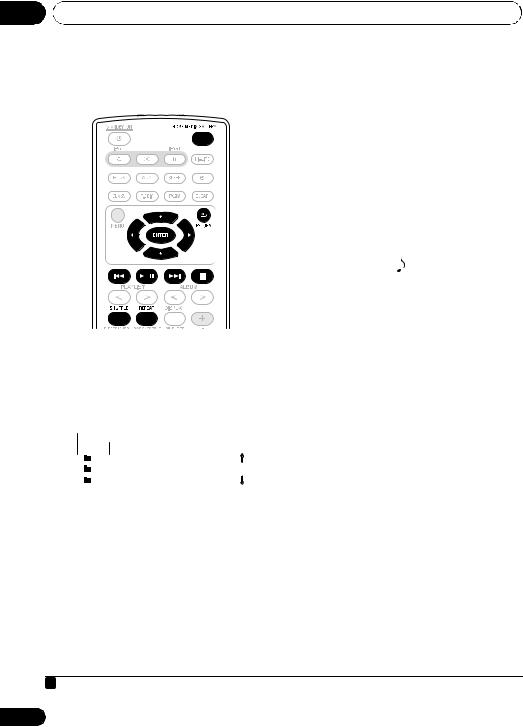
05 Playback with HOME MEDIA GALLERY inputs
•There are cases where the time elapsed may not be correctly displayed.
1 Press HOME MEDIA GALLERY.
It may take several seconds for this unit to access the network. The following screen appears when the Home Media Gallery is selected as the input function.
•Setup**- Allows the user to perform various network settings and confirm information.
•Recently played**- Internet Radio listening history (most recent 20 incidents) *: Is only displayed when connected.
**: Is displayed at all times.
3 Use / to select the folder, music files or Internet radio station, and then press ,
ENTER or /.
Press / to scroll up and down the list and select the desired item.
Only audio files with can be played. When you press ENTER, playback starts with the playback screen being displayed for the selected item.
To return to the list screen, press RETURN.
In case of the folders with  , use /and or ENTER to select the desired folder and audio files.
, use /and or ENTER to select the desired folder and audio files.
For detailed operating instructions, refer to the section shown below.
• Playback screen - See page 25.
Selected
Input function |
|
|
|
|
|
|
|
|
|
> U S B |
|
|
|
|
I n |
t e r n e t |
R a d |
i |
|
S e |
r v e r 1 |
1 |
/ 6 |
|
|
|
|||
|
|
|
|
|
Current page/Total pages
2 Use / to select the category, and then press or ENTER.
Select a category from the following list1:
•USB* - the USB storage device
•Server Name* - Server components on the network
•Internet Radio**- Internet radio
•Favorites**- Favorite songs currently being registered
• Favorites folder - See page 25.
You can perform the following operations with the remote control of this unit. Note that some buttons are not available for operation depending on the category currently being played back.
Button |
What it does |
/ |
Starts normal playback and pauses/ |
|
unpauses playback. |
|
|
|
Stops playback. |
|
|
|
Press to skip to the start of the |
|
current file, then previous files. |
|
|
|
Press to skip to the next file. |
|
|
VOLUME |
Use to set the listening volume. |
+/– |
|
|
|
 Note
Note
1 When RETURN is pressed from this menu, the last internet radio station listed to will be selected.
24
En

Playback with HOME MEDIA GALLERY inputs
Button |
What it does |
|
|
SHUFFLE The currently selected tracks are played back in random order (shuffle play).
REPEAT The currently selected tracks are played back repeatedly.
DISPLAY Switches the track information (artist name/album name) each time the button is pressed during playback.
DISP OFF Turns the display off except when pressing the buttons.
When the top menu is displayed on this unit’s display and this unit is not operated for 30 minutes or more after the Home Media Gallery function is selected, power will automatically turn OFF.
About the playback screen
The following screen appears when you play back audio files. Note that some items may not be displayed depending on the type of file.
Input sourceSong name
|
|
|
|
|
|
|
U |
S B |
|
|
|
|
|
S |
o |
n |
g |
n |
a m e |
|
A |
r |
t |
i |
s t |
n a |
m e |
|
|
|
|
|
|
0 : 0 0 |
Time
Artist name/Album name
Play mode
: Repeat 1
: Repeat all

 : Shuffle
: Shuffle
•During playback, each time DISPLAY is pressed, the displayed information (artist name/album name) alternates.
The following screen appears when audio streams from an Internet radio station are received.
Song name
Radio station name
|
|
|
|
I n t e r n e t |
|
R a d i o |
|
S o n g n a m e |
|
|
|
1 . R a d i o |
s |
t a t i o n |
|
|
|
0 : 0 |
0 |
The list of Internet radio stations on this unit is created, edited, and managed by the vTuner database service exclusively for use with this unit. See page 26.
About the Favorites folder
You can register up to 20 of your favorite songs or Internet radio stations in the Favorites folder. Note that only the audio files stored on components on the network can be registered.
Registering audio files and Internet radio stations in the Favorites folder
• Press PGM while a song or an Internet radio station is being played back or stopped.
Deleting audio files and Internet radio stations from the Favorites folder
• Use / to select the folder, music files or Internet radio station, and then press CLEAR.
05
Español Français English
25
En
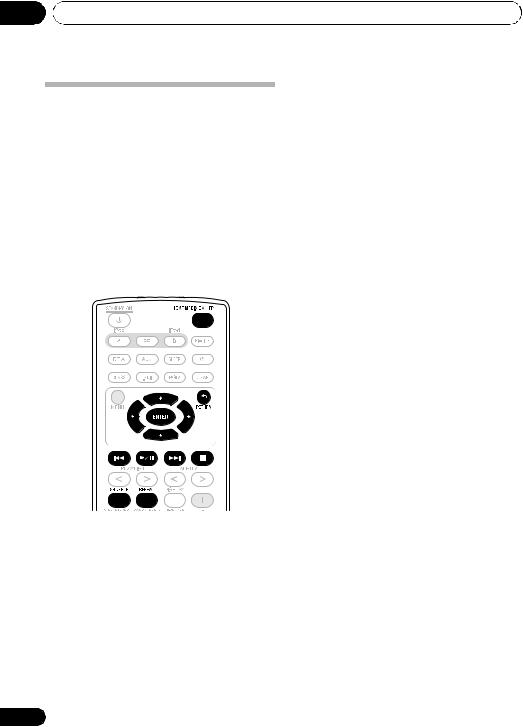
05 Playback with HOME MEDIA GALLERY inputs
Registering broadcast stations not on the vTuner list from the special Pioneer site
With this unit, broadcast stations not included on the list of station distributed by vTuner can be registered and played. Check the access code required for registration on this unit, use this access code to access the special Pioneer Internet radio site and register the desired broadcast stations in your favorites. The address of the special Pioneer Internet radio site is:
http://www.radio-pioneer.com
1Display the Internet Radio list screen.
To display the Internet Radio list screen, perform steps 1 to 3 at Playback with Home Media Gallery on page 23
2Use / to select ’Help’, then press
ENTER.
3Use /to select ’Get access code’, then
press ENTER.
The access code required for registration on the special Pioneer Internet radio site is displayed. Make a memo of this address.
The following can be checked on the Help screen:
•Get access code - The access code required for registration on the special Pioneer Internet radio site is displayed.
•Show Your WebID/PW - After registering on the special Pioneer Internet radio site, the registered ID and password are displayed.
•Reset Your WebID/PW - Resets all the information registered on the special Pioneer Internet radio site. When reset, all the registered broadcast stations are also cleared. If you want to listen to the same stations, re-register after resetting.
4 Access the special Pioneer Internet radio site from your computer and perform the
registration process.
Access the above site and use the access code in step 3 to perform user registration, following the instructions on the screen.
5 Register the desired broadcast stations as your favorites, following the instructions on
the computer’s screen.
Both broadcast stations not on the vTuner list and stations on the vTuner list can be registered. In this case they are registered on the unit as favorite broadcast stations and can be played.
26
En
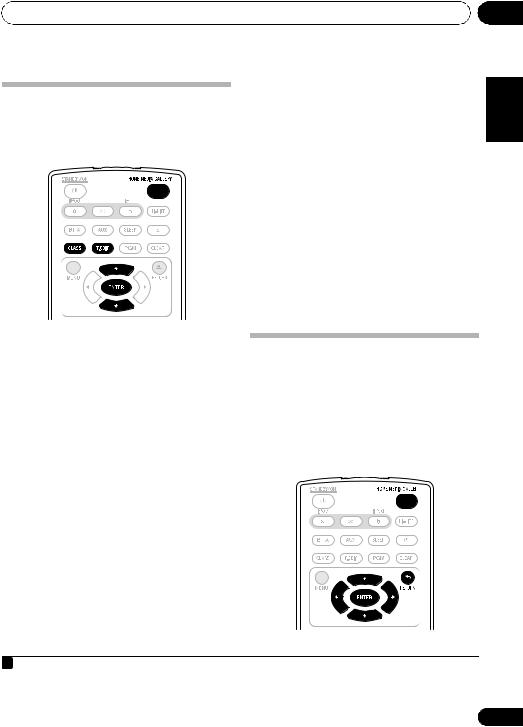
Playback with HOME MEDIA GALLERY inputs |
05 |
Advanced operations for Internet radio
Saving Internet radio stations
This unit can remember the Internet radio stations that you often listen to in three classes (A to C) with up to ten stations in each class to make the total of 30 stations at its maximum capacity.
Before proceeding with the following steps, check whether you have followed Steps 1 to 3 at Playback with Home Media Gallery on page 23.
1Tune into the Internet radio station.
Tune into the desired Internet radio station by following Steps 1 to 3 at Playback with Home Media Gallery on page 23.
2Press T.EDIT to switch to the station saving mode.
3Press CLASS.
Select the desired class from A to C.
4 Use / to select the number, and then
press ENTER.
Select the desired number from 0 to 9.
Retrieving saved Internet radio
stations
You need to save Internet radio stations first before retrieving them. If there are no Internet radio stations currently being saved, see
Saving Internet radio stations above and save at least one Internet radio station before proceeding with the following steps.
1 Press CLASS.
Each time you press CLASS, the class switches to A to C in turn.
2 Use / to select the station number.
’No Preset’ appears when you select an Internet radio station currently not being saved.
Setting up the network
In case the router connected to the LAN terminal on this unit is a broadband router (with the built-in DHCP server function), simply turn on the DHCP server function, and you will not need to set up the network manually. You must set up the network as described below only when you have connected this unit to a server without the DHCP server function.1
Español Français English
 Note
Note
1In case you make changes to the network configuration without the DHCP server function, make the corresponding changes to the network settings of this unit. Before you set up the network, consult with your ISP or the network manager for the required settings. It is advisory that you also refer to the operation manual supplied with your network component.
27
En

05 Playback with HOME MEDIA GALLERY inputs
1 Press HOME MEDIA GALLERY to select
‘Home Media Gallery‘ as the input function.
It may take several seconds for this receiver to access the network.
2Select ’SETUP’ and press ENTER.
The SETUP screen appears.
3Select ’Network Setup’ and press ENTER.
The Network Setup screen appears.
Either ‘Network Found‘ or ‘No Network Found‘ appears on the Network Setup screen.
•Network Found - Connected to a component on the network.
•No Network Found - Not connected to a component on the network.
4 Check the network connection status and
press ENTER.
The Network IP Settings screen appears.
5 Select ‘Automatic (DHCP) ‘or ‘Static IP‘ and press ENTER.
•Automatic (DHCP) - The network is automatically set up.
•Static IP1 - The network is manually set up. Proceed with the following steps.
1Select ’Change’ and press ENTER.
The Edit IP address screen appears.
2Enter the IP address.
Press / to select a number and /
to move the cursor. After you select the last number, press or ENTER. The Proxy Server screen appears.
6 Select ‘No‘ or ‘Yes‘ for the proxy server setting to deactivate or activate the proxy server, and press ENTER.
•No - The Top Menu screen appears.
•Yes - The Proxy Name screen appears. Proceed with the following steps.
1Select ’Change’ and press ENTER.
The Edit Proxy Name screen appears.
2Enter the address of your proxy server
or the domain name.
After entry, press or ENTER. The Proxy Port screen appears.
3 Select ’Change’ and press ENTER.
The Edit Proxy Port screen appears.
4 Enter the address of your proxy server
or the domain name.
Press / to select a number and /to move the cursor. After you select the last number, press or ENTER. The Settings OK? screen appears.
5 Press ENTER to complete the network
setup procedure.
The Top Menu screen appears.
 Note
Note
1IP Address
The IP address to be entered must be defined within the following ranges. If the IP address defined is beyond the following ranges, you cannot play back audio files stored on components on the network or listen to Internet radio stations.
Class A: 10.0.0.1 to 10.255.255.254 / Class B: 172.16.0.1 to 172.31.255.254 / Class C: 192.168.0.1 to 192.168.255.254
Subnet Mask
In case an xDSL modem or a terminal adapter is directly connected to this unit, enter the subnet mask provided by your ISP on paper. In most of the cases, enter 255.255.255.0.
Gateway IP
In case a gateway (router) is connected to this unit, enter the corresponding IP address.
DNS (1st)/DNS (2nd)
In case there is only one DNS server address provided by your ISP on paper, enter ‘DNS (1st)’. In case there are more than two DNS server addresses, enter ‘DNS (2nd)’ in the other DNS server address field.
Proxy Name/Proxy Port
This setting is required when you connect this receiver to the Internet via a proxy server. Enter the IP address of your proxy server in the ‘Proxy Name’ field. Also, enter the port number of your proxy server in the ‘Proxy Port’ field.
28
En

Playback with HOME MEDIA GALLERY inputs |
05 |
Checking the network settings
You can check the following network settings of this unit: the MAC address, the IP address, the gateway IP address, the proxy server, the Subnet mask, and the firmware version (for the Home Media Gallery of this unit).
Before proceeding with the following steps, check whether you have followed Steps from 1 to 2 at Setting up the network on page 27.
1 Select ‘Information‘ and press ENTER to
confirm your selection.
The Firmware Version (for the Home Media Gallery of this unit) screen appears.
2 Check the network settings.
Press / to switch the display. Each time you press /, the display switches as follows.
Firmware Ver. MAC Address IP Address Gateway IP Proxy ServerSubnet Mask
3 Press RETURN.
The Setup screen appears. To return to the Top Menu screen, press RETURN again.
Ext. Vol Limit
“Ext. Vol Limit” controls the maximum value when adjusting the sound volume from an external controller (Digital Media Controller1 (DMC)). The maximum of volume is changed from ‘50’ into ‘30’.
 Important
Important
•When Home Media Gallery function is selected and both the iPod/iPhone connector ports is not connected, Ext. Vol Limit works.
1Press HOME MEDIA GALLERY.
2Disconnect iPod/iPhone units from the iPod/iPhone connector ports.
3Press  , and then STANDBY/ON for three seconds to switch Ext. Vol Limit
, and then STANDBY/ON for three seconds to switch Ext. Vol Limit
between on and off.
When Ext. Vol Limit is on, ‘Ext. Vol Limit On’ is displayed on this unit’s display.
Español Français English
 Note
Note
1 Refer to Enjoying the Home Media Gallery on page 20.
29
En

05 Playback with HOME MEDIA GALLERY inputs
DLNA
About network playback
The network playback function of this unit uses the following technologies:
Windows Media Player
Windows Media Player is software to deliver music, photos and movies from a Microsoft Windows computer to home stereo systems and TVs.
With this software, you can play back files stored on the PC through various devices wherever you like in your home.
This software can be downloaded from Microsoft’s website.
Windows Media Player 11 (for Windows XP, Vista)
Windows Media Player 12 (for Windows 7)
For more information check the official Microsoft website.
Windows Media DRM
Microsoft Windows Media Digital Rights Management (WMDRM) is a platform to protect and securely deliver content for playback on computers, portable devices and network devices. Home Media Gallery functions as a WMDRM 10 for networked devices. WMDRM protected content can only be played on media servers supporting WMDRM.
Content owners use WMDRM technology to protect their intellectual property, including copyrights. This device uses WMDRM software to access WMDRM protected content. If the WMDRM software fails to protect the content, content owners may ask Microsoft to revoke the software’s ability to use WMDRM to play or copy protected content. Revocation does not affect unprotected content. When you download licenses for protected content, you agree that Microsoft may include a revocation list with the licenses. Content owners may require you to upgrade WMDRM to access their content. If you decline an upgrade, you will not be able to access content that requires the upgrade. This product is protected by certain intellectual property rights of Microsoft. Use or distribution of such technology outside of this product is prohibited without a license from Microsoft.
DLNA CERTIFIED™ Audio Player
The Digital Living Network Alliance (DLNA) is a cross industry organization of consumer electronics, computing industry and mobile device companies. Digital Living provides consumers with easy sharing of digital media through a wired or wireless network in the home.
The DLNA certification logo makes it easy to find products that comply with the DLNA Interoperability Guidelines. This unit complies with DLNA Interoperability Guidelines v1.5.
When a PC running DLNA server software or other DLNA compatible device is connected to this player, some setting changes of software or other devices may be required. Please refer to the operating instructions for the software or device for more information.
DLNA and DLNA CERTIFIED are trademarks and/or service marks of the Digital Living Network Alliance.
Content playable over a network
•Even when encoded in a compatible format, some files may not play correctly.
•Movie or Photo files cannot be played back.
•There are cases where you cannot listen to an Internet radio station even if the station can be selected from a list of radio stations.
•Some functions may not be supported depending on the server type or version used.
•Supported file formats vary by server. As such, files not supported by your server are not displayed on this unit. For more information, check with the manufacturer of your server.
30
En
